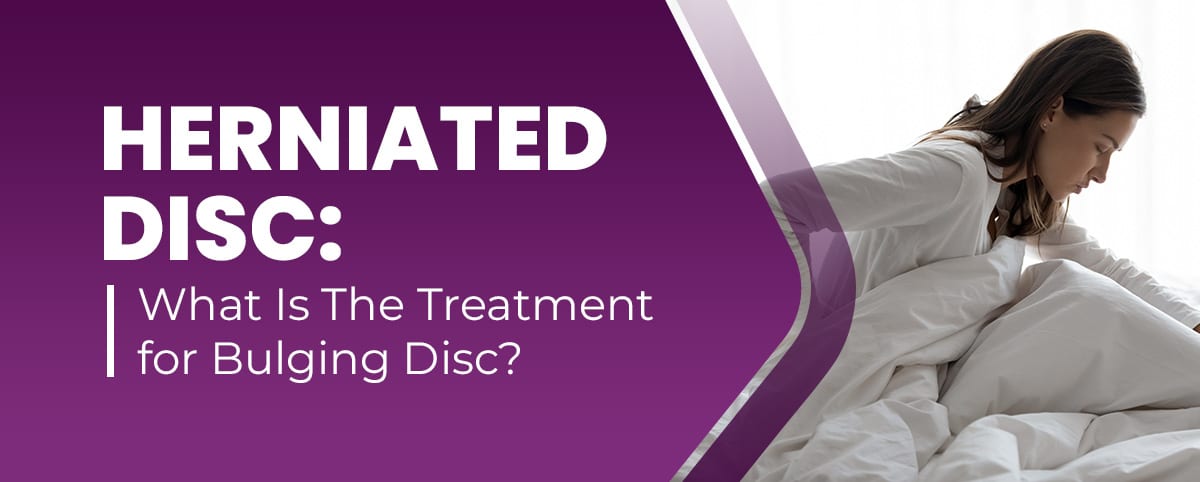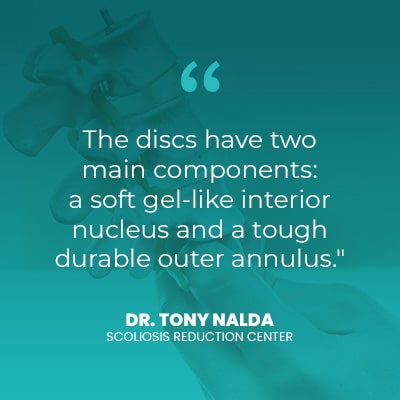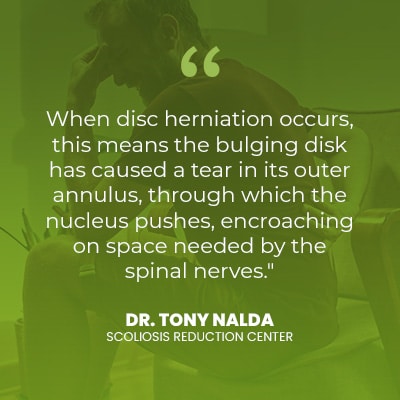Herniated Disc: What Is The Treatment for Bulging Disc?

The intervertebral discs are often the first structures to feel the effects of spinal degeneration, and in light of the many important roles they play, their deterioration can cause a number of issues.
The intervertebral discs are key to the spine's overall health and function; they consist of a gel-like interior and a tough durable outer layer. A herniated disc occurs when its inner nucleus pushes out through a tear in its outer annulus, which is prefaced by a bulging disc.
Disc problems can develop for a number of reasons, and have a number of effects, so let's start with exploring the structure of the discs and their role in preserving spinal health and function.
Table of Contents
What are Intervertebral Discs?
The basic structure of the spine consists of vertebrae (bones of the spine) stacked on top of one another in a straight and neutral alignment, and these vertebrae are separated by intervertebral discs.
If the spine is aligned, this means its natural curves are preserved, and this is important because the spine's healthy curves make it stronger, more flexible, and better able to absorb/distribute mechanical stress incurred during movement.
An intervertebral disc sits between adjacent vertebrae, and it provides cushioning to prevent friction during movement, facilitates flexible movement, provides the spine with structure (adjacent vertebrae attach to the disc in between), and acts as the spine's shock absorbers.
Disc Structure
 The discs have two main components: a soft gel-like interior nucleus and a tough durable outer annulus.
The discs have two main components: a soft gel-like interior nucleus and a tough durable outer annulus.
The discs are made up of water, collagen, and proteoglycans, and the big issue with the spinal discs is that they are the largest structures inside the body without their own vascular supply, meaning there is no direct path into the discs through which they can absorb important nutrients needed for repair; this is why disc deterioration is difficult to reverse.
So now that we have explored the spinal discs in terms of structure and function, let's talk about what can happen when they start to deteriorate and/or become damaged.
Disc Deterioration
As mentioned, the discs of the spine are often the first spinal structures to feel the effects of degenerative changes, and this is because of the many roles they play in spinal function, plus their avascular nature.
When we're born, the discs are made up of 80-percent water, but as we age, that fluid level decreases, and if a disc becomes desiccated (excessive fluid loss), which is a common feature of degenerative disc disease, it can change shape, affecting the vertebrae and nerve roots surrounding it.
If a disc changes shape, its inner nucleus can bulge out at its edges, pushing against its outer annulus, somewhat how a marshmallow would look when compressed between two cookies; this is a bulging disk.
A disc that's bulging introduces uneven pressure to its surroundings, and is encroaching on the space in and around the spine that's used by spinal nerves, and an affected nerve can cause a host of issues.
For example, if a bulging disc is located in the lumbar spine (lower back), the sciatic nerve, that originates in the lumbar spine, can become compressed, which can cause pain felt anywhere along its extensive pathway.
Now, the important thing about a bulging disc is being proactive with treatment to avoid the progression to disc herniation.
Bulging Disc Treatment
When it comes time to address a bulging disc, here at the Scoliosis Reduction Center, treatment is driven by a condition's underlying cause: the difference between solely addressing condition symptoms, or the condition itself.
For bulging discs, I aim to restore as much natural disc function as possible, prevent further deterioration, and address related areas of spinal subluxation.
Once I've determined the underlying cause of a bulging disc, I can craft a customized treatment plan that addresses the specifics of the condition.
Integrating Multiple Treatment Modalities
I use a conservative chiropractic-centered treatment approach that involves integrating multiple forms of treatment for the best potential results: chiropractic care, in-office therapy, and custom-prescribed home exercises.
When it comes to managing pain, I can also apply hot/cold therapy, and through chiropractic care, I can treat the entire spine to make improvements to overall health, function, and biomechanics.
Diagnosing Disc Issues
Here at the Clinic, the assessment/diagnostic process can involve orthopedic and neurological testing to monitor the level of reflex response, brain-body communication, nerve sensation, and muscle strength.
Disc herniation can be diagnosed through magnetic resonance imaging and a ct scan, and nonsurgical treatment can be less invasive than spinal injections, an epidural steroid injection, and artificial disk surgery.
I also observe how a patient walks, holds themselves (posture), and when needed, X-rays can confirm a diagnosis and gauge what's going on in and around the spine.
I can also tell a lot about a condition by a patient’s gait, balance, movement, and overall posture, and when necessary, I can order an X-ray to confirm a diagnosis and really see what’s going on in and around the spine.
By proactively addressing disc health and function, pain management can be achieved because the underlying cause of the pain is being addressed.
Through a variety of chiropractic techniques, I can assess if a bulging disc has caused areas of joint dysfunction or restricted spinal movement, as this can be a cause of disc degeneration, or be a result.
Through a series of manual chiropractic adjustments and spinal manipulation techniques, I can work towards repositioning spinal bones that are affected by a bulging disc, and this relieve pressure on disc, the spinal nerves, and can facilitate the return of a disc's inner nucleus to its central position inside its annulus.
While there are surgical treatments for bulging discs, I offer less-invasive non-surgical treatments.
Nonsurgical Treatment Options
I can also use flexion-distraction therapy and manipulation under anesthesia (MUA) to help improve the health of the discs, their surroundings, and provide pain relief.
There are also a variety of physical therapy techniques I can apply to help increase core and spinal strength to address muscle weakness and help reduce related muscle spasms and relieve pain.
Condition-specific exercises and stretches can also help improve the circulation around an affected disc, as this is the means by which the discs absorb oxygen and nutrients needed for cellular repair and restoration: necessary due to the discs' avascular nature.
Being proactive with treatment, means potentially preventing the development of a herniated disc.
When a Bulging Disc Becomes a Herniated Disc
 When disc herniation occurs, this means the bulging disk has caused a tear in its outer annulus, through which the nucleus pushes, encroaching on space needed by the spinal nerves.
When disc herniation occurs, this means the bulging disk has caused a tear in its outer annulus, through which the nucleus pushes, encroaching on space needed by the spinal nerves.
Potential symptoms of a herniated disc can include spinal nerve inflammation, nerve compression, nerve damage, nerve pain, chronic back pain, and severe pain in general.
As you can see, the effects of disc herniation can be severe, so the key is being proactive with a disc that's bulging so it doesn't cause disc herniation.
The level and location of herniated disc pain will depend on its location within the spinal sections.
For example, a herniated lumbar disc, as it's located in the lower spine, tends to directly affect the lower body so can cause leg pain, bladder or bowel function, bowel control issues, in addition to back pain, muscle weakness, and general back pain.
A herniated disc in the cervical spine is most likely to cause neck pain and related muscle weakness, and while muscle relaxants and nonsteroidal anti inflammatory drugs nsaids can help alleviate pain, this will only be short term as nonsteroidal anti inflammatory medications are only addressing symptoms of a herniated disc, but not the herniated disc itself.
Conclusion
As the spine is involved in the function of virtually every working system within the body, the effects of its degeneration can be widespread.
Symptoms of a disc that's bulging can include back or neck pain, leg pain, back pain, and if bulging discs are left untreated, they can progress to becoming herniated, known to make pain worse and put more pressure on the spinal cord and its surroundings.
When it comes to addressing disc issues, here at the Center, I offer patients nonsurgical treatments as an alternative to invasive spinal surgery, and that can proactively prevent herniated disks.
Through a series of chiropractic adjustments and physical therapy, I can work towards addressing any areas of spinal subluxation, take pressure off the spinal cord and its surrounding spinal nerve roots, prevent further damage, and preserve as much natural disc/spinal function as possible.
In addition, proactively addressing the underlying cause of spinal conditions can help provide significant pain relief for the long term, rather than the short-term effects of prescription medication and epidural steroid injections.
So the time to start bulging disc treatment is always now, in the interest of prevention so herniated discs don't become a future related issue.
Dr. Tony Nalda
DOCTOR OF CHIROPRACTIC
After receiving an undergraduate degree in psychology and his Doctorate of Chiropractic from Life University, Dr. Nalda settled in Celebration, Florida and proceeded to build one of Central Florida’s most successful chiropractic clinics.
His experience with patients suffering from scoliosis, and the confusion and frustration they faced, led him to seek a specialty in scoliosis care. In 2006 he completed his Intensive Care Certification from CLEAR Institute, a leading scoliosis educational and certification center.
About Dr. Tony Nalda
 Ready to explore scoliosis treatment? Contact Us Now
Ready to explore scoliosis treatment? Contact Us Now





